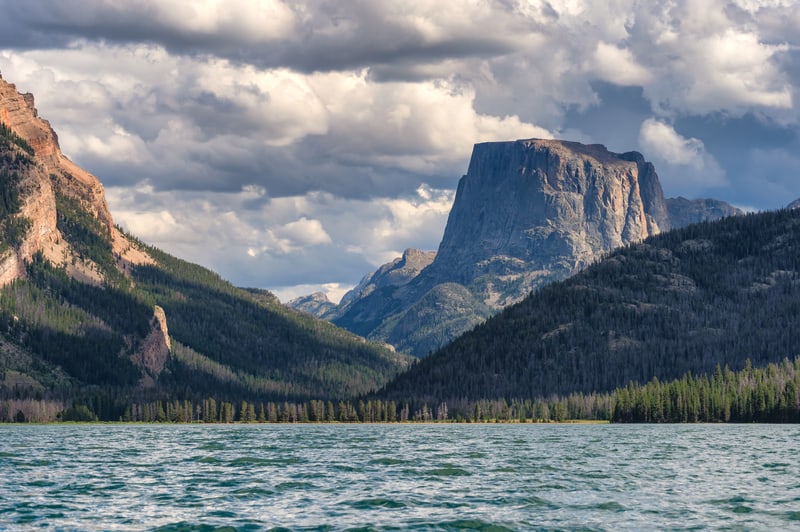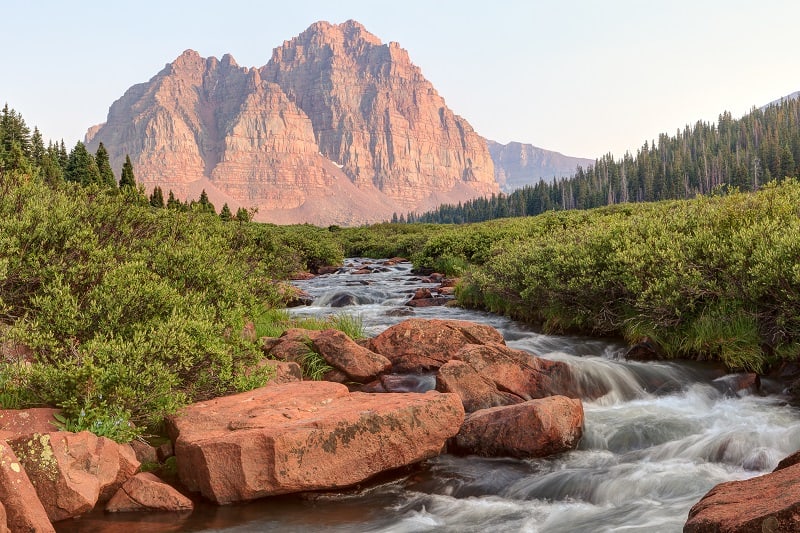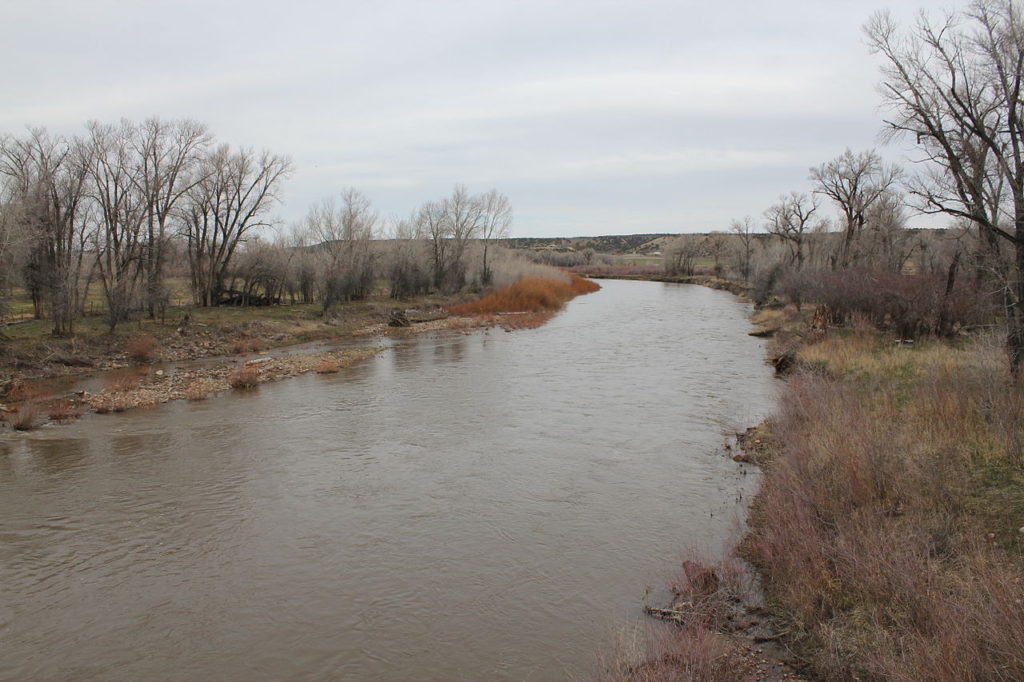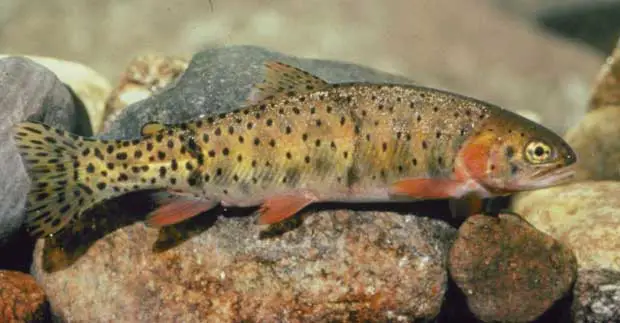The Colorado River cutthroat trout is one of the four subspecies that an angler will need to catch and document to complete the slam. This article will tell you where to find Colorado River Cutthroat Trout in Wyoming.
The Wyoming Cutt- Slam was designed to bring attention to restoring Cutthroat Trout to its native environment. The Slam also creates enthusiasm for catching native Cutthroat Trout.
The Green River and its Tributaries
Colorado Cutthroat Trout are native to the Colorado and Green River Basins. The Green River is a major tributary of the Colorado River. The Green River heads up in the Wind River Mountains. North of Pinedale, Wyoming. Waters that hold Colorado River Cutthroat Trout in the state of Wyoming will be the Green River, its headwaters, and its tributaries.
Restoring Native Trout
Even in some of the most pristine wilderness in the west, it’s difficult to find trout native to that area. With the settling and taming of the Western United States by European Americans, some of the native flora and fauna didn’t cope well with the new realities that came along with it. Consequently, native Cutthroat Trout now only inhabit a fraction of their former range for many reasons.
Today there is a renewed interest on the part of anglers to catch native trout in their native environment that their ancestors swam in long before the United States of America. Undisturbed native populations are being identified and protected. In other areas, nonnative trout species are being removed and replaced with natives.
Upper Green River

Green River Lakes
The Green River ultimately comes from Glaciers high up in the Wind River Mountains. Green River Lakes are considered by most people to be the headwaters of the Green River. It flows through some other lakes like Peak Lake before getting to the Green River Lakes, though. The Green River does flow through the Green River Lakes, and they are in one of the most beautiful settings on Earth.
The Fish you’ll find there are as follows. Mackinaw (Lake Trout) Brook, Rainbow, Brown, and Colorado River Cutthroat trout.
The upper Green River Lake lies within the Bridger Wilderness. You can drive to the lower one, though. From Pinedale, Wyoming, drive 7 miles west on U.S. Highway 191. Turn north onto Wyoming Highway 352 and continue 25 miles to the forest boundary, where the pavement ends. Continue on the dirt road for 18 miles to the campground. There is a first-come, first-served campground with 39 units in the trees near the lower lake’s lower edge.
La Barge Creek
La Barge Creek has its beginnings in the Wyoming range. It flows south and east to eventually empties into the Green River. It has a diverse trout population. Though, including its tributaries, it has a newly restored Colorado River cutthroat trout population in its upper sections. According to Hilda Sexauer, Pinedale regional fisheries supervisor, the upper La Barge Creek has been the subject of the largest native trout recovery in the history of Wyoming’s state.
Removing Non Native Trout
In 2001 a fish barrier was installed in lower La Barge creek to prevent nonnative fish from migrating upstream. Then, 18 miles of La Barge Creek plus 19 tributaries for a total of around 58 stream miles were treated with antimycin and rotenone to remove all unwanted fish species.
In 2007, upper La Barge Creek was stocked with genetically pure Colorado River Cutthroat Trout, both of fingerling and catchable sizes. The goal is to end stocking once the population is self-sustaining.
The following road directions are from the Wyoming Game and Fish Department Website.
“How to get there – From county road 235 on the south end of the town of La Barge, go about one mile on highway 189 to county road 315. This paved road heads due west toward the mountains and enters the Bridger National Forest in about 24 miles. The now-gravel road continues to parallel La Barge Creek for a long way, but the instream flow segment only extends upstream about 3 miles from the Forest boundary to the mouth of Turkey Creek. This is a relatively well-traveled road, so be sure to park well out of the main travel lanes. Also, note that while this road is deceptively smooth and graded, it is well known for its many sharp rocks that can turn a good tire into a flat tire on vehicles traveling too fast.”
North Piney Creek
North Piney Creek is managed as a wild fishery for native Colorado River Cutthroat Trout. According to the Wyoming Game and Fish Department website, the stream is large enough to produce trout up to 18 inches long or longer but still small enough to wade.
North Piney Lake is located in the headwaters of this drainage. This is where the WGFD hatcheries collect adult Colorado River Cutthroat trout to produce stockable fish for restoring this native fish to their historic range.
Area 4 flowing water fishery regulations apply to the entire stream. This means there’s a limit of three trout per day or in possession. And the only one can be over 16 inches long. Upstream from the Forest Service boundary, anglers are limited to artificial flies and lures only.
To get to North Piney Creek, take the Middle Piney Road (Highway 350) west, about 18 miles from Big Piney. After the road crosses the Forest Service boundary, it splits. At this point, take the right-hand fork north about 6 miles.
Other Wyoming Range Streams
There are several other tributary streams to the Green River coming from the Wyoming Range that holds Colorado River Cutthroat Trout:
- Beaver Creek
- Horse Creek
- North Horse Creek, which is a tributary of Horse Creek
- Spring Creek, which is a tributary of North Horse Creek
- North Cottonwood Creek
- South Cottonwood Creek Little Cottonwood Creek
- Beecher Creek, which is a tributary of Little Cottonwood Creek
- Camp Creek, which is a tributary of Beecher Creek
- Muddy Creek along with its north and south branches
- Dry Piney Creek
- Hogarty Creek, which is a tributary of Dry Piney Creek
- Sawmill Creek and Pine Grove Creek which are tributaries of Hogarty Creek
- Black Canyon Creek which is a tributary of Dry Piney Creek
I’ve italicized the waters that have Colorado River Cutthroat Trout exclusively.
Hotels handy to the location are found at Pinedale and Big Piney, Wyoming.
Uinta Mountains
The Black’s Fork of the Green River
The headwaters of the Black’s Fork of the Green River are actually in Utah. The East, Middle, and West Forks of the Back’s Fork River come down off the North Slope of the Uinta Mountains. The Uinta Mountains are an East, West range of mountains in northeastern Utah extending into southern Wyoming.
The different Branches of the Black’s Fork River converge at Meek’s Cabin Reservoir, also in the Uinta range. A small portion of Meeks Cabin reservoir lies south of the border in Utah. The majority of the 470-acre impoundment, though, lies in Wyoming. There is a 24-site campground at Meeks Cabin Reservoir.
You’ll find Colorado River Cutthroat Trout and Mountain Whitefish in Meeks Cabin Reservoir.
At Meek’s Cabin Reservoir outlet, the Black’s Fork of the Green River proper begins. It travels 175 stream miles picking up the Smith Fork and Ham’s Fork rivers along the way to eventually join up with the Green River at Flaming Gorge Reservoir. Along with the Colorado River Cutthroat Trout and Whitefish, the Blacks Fork also holds Brown and Rainbow Trout. In its lower stretches, it turns into more of a warm water fishery and features Channel Catfish.
Horse Creek
Horse Creek is a tributary of the Blacks Fork River that arises on the North Slope of the Uinta Mountains east of the Blacks Fork. It crosses into Wyoming and joins the Blacks Fork approximately 16 miles west and a little north of Robertson Wyoming. According to the Wyoming Dept. of Game and Fish Web site Horse Creek has Colorado River Cutthroat Trout exclusively.
Willow Creek
Willow Creek arises on the North Slope of the Uinta Mountains east of Horse Creek and West of the West Fork of the Smiths Fork. It crosses into Wyoming and joins the West Fork of the Smiths Fork, approximately 14 miles to the South and a little west of Robertson Wyoming on Uintah County road 279. Along with Colorado Cutthroat Trout, it also holds Brook and Rainbow Trout.
Sage Creek
Sage Creek arises from the north slope of the Uinta Mountains and crosses the border from Utah to Wyoming, east of Cottonwood Creek and west of the Henry’s Fork. It joins Cottonwood Creek south and east of Mountain View Wyoming, approximately where Cottonwood Creek crosses under Wyoming state route 414-E. Cottonwood Creek, in turn, eventually joins the Smiths Fork. Sage Creek towards the Utah line exclusively holds Colorado River Cutthroat Trout.
I’ll also add Little Sage Creek here; it originates to the East of Sage Creek on the Wyoming side of the Border. It is a tributary of Sage Creek. It also exclusively holds Colorado River Cutthroat Trout.

Smiths Fork
The headwaters of the Smiths Fork are on the North Slope of the Uintah Mountain range. It arises to the east of the Blacks Fork and somewhat parallels its course. It eventually joins the Blacks Fork approximately eight miles to the northeast of Lyman, Wyoming. In Addition to Colorado River Cutthroat Trout, the Smiths Fork also holds Brook Trout, Colorado River Cutthroat, Mountain Whitefish, Rainbow Trout, Tiger Trout. A Tiger Trout is a sterile offspring from crossing Brook and Brown Trout.
Henry’s Fork
The Henry’s Fork comes off the north slope of the Uinta Mountains in Utah and crosses into Wyoming. It flows approximately 61 miles in total to Join the Green River at Flaming Gorge Reservoir. The Henry’s Fork carries Colorado River Cutthroat Trout and Rainbow Trout. In its tributaries, there are “non-Colorado River Cutthroat Trout,” so if you’re looking for a fish to complete your Wyoming Cutthroat slam, this is maybe not the place to go. Still, if finding specifically a Colorado River Cutthroat is not a priority for you, I’m adding what information I’ve found.
Beaver Creek
Beaver Creek’s east and west forks come down off the Uinta Mountains north slope and cross into Wyoming from Utah. In Wyoming, they join together into one stream and join Henry’s Fork approximately 3 miles to the east of Lone Tree, Wyoming. The Wyoming Game Department’s website lists the East Fork of Beaver Creek containing both Colorado River Cutthroat Trout and Snake River Cutthroat Trout.
Burnt Fork
Burnt Fork also comes down off the north slope of the Uinta Mountains. It crosses from Utah into Wyoming and joins Henry’s Fork approximately 8 miles to the east of Lone Tree, Wyoming. Its Trout species are listed as Cutthroat Trout in the generic sense. I suspect that Cutthroat subspecies other than the Colorado River have been planted in its headwaters in past times.
Uinta North Slope Places to Stay
The proceeding rivers and streams from the Blacks Fork to the Burnt Fork are all found in the same general area proceeding down from the North Slope of the Uinta Mountains. It’s a good area to stay and explore for a while. This is a sparsely populated, primarily agricultural area. There are some motels in the vicinity, though, so I’ll list them.
- Gateway Inn@ 106 E Clark St, Lyman, WY 82937 (307) 787-3700
- Country Cabins Inn@ 21 7th St, Mountain View, WY 82939 (307) 782-7888
- Highlander Inn@ 270 North Main St, Fort Bridger, WY 82933 (307) 782-6361
- Lyman KOA Campground@ 1531 WY-413, Lyman, WY 82937 (307) 786-2188

Little Snake River
The Little Snake River meanders along both north and south of the Wyoming Colorado border in Baggs Wyoming’s vicinity. In its lower stretches, it’s more of a warm water fishery. In its headwaters and tributaries, it’s a Colorado River Cutthroat Trout fishery.
Look for Colorado River Cutthroat Trout In the following tributaries of the Little Snake.
- Rhodine Creek
- Deadman Creek
- Bachelor Creek
- Alisha Creek
- Big Gulch Creek
- Mill Creek
- South Fork of Mill Creek
- Right Branch of Mill Creek
- Skull Creek
- Douglass Creek
- Deep Creek
- Big Sand Stone Creek
- Solomon Creek
- Rabbit Creek
- Sherard Creek
- Roaring Fork
- Fletcher Park Creek
- West Branch of Haskins Creek
- West Fork of Battle Creek
- Battle Creek
- Vole Creek
- Green Creek
- Haggerty Creek
- Deep Rock Creek
- Savory Creek
- High Savory Reservoir
- Hatch Creek
- Dirtyman Fork
- Joe Creek
The following are listed to have exclusively Colorado River Cutthroat Trout.
- Harrison Creek
- Dale Creek
- Third Creek
- Green Timber Creek
- Happy Creek
- Rose Creek
- Ted Creek
- Elk Creek
- The North Fork of the Little Snake River
- Deadline Creek
- Standard Creek
- The West Branch of The North Fork of the Little Snake River
- Upper Muddy Creek
- Hartt Creek
The above are all tributaries and headwater streams of the Little Snake River. Check with the Wyoming Game and Fish dept. Green River regional office for more in-depth details @307-875-3223.
Little Snake River Lodging
Lodging is available at both Baggs and Dixon, Wyoming. Here are some Hotel phone numbers.
- Cowboy Inn @ 210 Penland St #490, Baggs, WY 82321,
- Drifter’s Inn Motel @210 Penland St, Baggs, WY 82321 (307) 383-2200,
- Bobcat Inn @110 North St, Baggs, WY 82321 (307) 383-7059,
- Dixon Motel @ 217 Cottonwood ST #59, Dixon, WY 82323 (307) 383-2300
South of Green River and Rock Springs Wyoming
These are small desert tributary streams of the Green River. If a larger fish isn’t a priority for you and you like to ditch the crowds and explore, give this area a try. Again, for more in-depth details on these small streams, check with the Wyoming Game and Fish Department’s Green River regional office. You’ll find the phone number in the previous paragraph.
- Red Creek
- Little Red Creek
- Trout Creek
- Currant Creek
- Gooseberry Creek
- Sage Creek.
There are numerous motels in both Green River and Rock Springs.
Good Luck on Filling Your Wyoming Cutthroat Slam
You’ll explore some country that you’ve probably never seen before, and hopefully, you’ll gain a deeper appreciation for native western trout.
Colorado River Cutthroat trout is just one of four subspecies included in the slam. Below are links to informational articles on the other three.
Recent Posts
The only venomous snakes in Washington State are Northern Pacific Rattlesnakes. The Northern Pacific Rattlesnake (Crotalus oreganus oreganus) is a sub-species of the Western Rattlesnake. Anyone...
Skunks are not classified as true hibernators. But they go into a state of torpor when the weather gets cold. Skunks are light sleep hibernators, along with opossums, bears, and raccoons. ...

